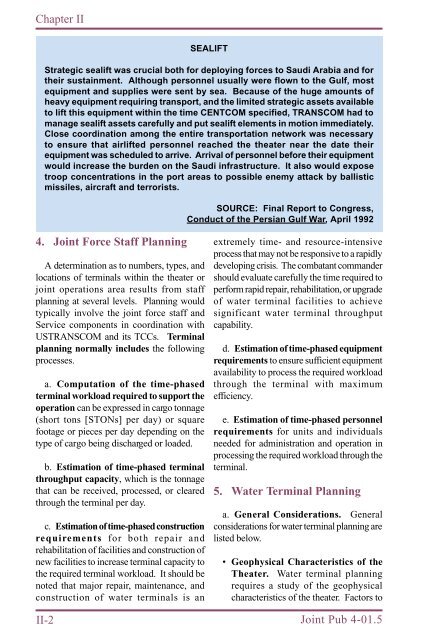JP 4-01.5 JTTP for Water Terminal Operations - BITS
JP 4-01.5 JTTP for Water Terminal Operations - BITS
JP 4-01.5 JTTP for Water Terminal Operations - BITS
Create successful ePaper yourself
Turn your PDF publications into a flip-book with our unique Google optimized e-Paper software.
Chapter II<br />
4. Joint Force Staff Planning<br />
A determination as to numbers, types, and<br />
locations of terminals within the theater or<br />
joint operations area results from staff<br />
planning at several levels. Planning would<br />
typically involve the joint <strong>for</strong>ce staff and<br />
Service components in coordination with<br />
USTRANSCOM and its TCCs. <strong>Terminal</strong><br />
planning normally includes the following<br />
processes.<br />
a. Computation of the time-phased<br />
terminal workload required to support the<br />
operation can be expressed in cargo tonnage<br />
(short tons [STONs] per day) or square<br />
footage or pieces per day depending on the<br />
type of cargo being discharged or loaded.<br />
b. Estimation of time-phased terminal<br />
throughput capacity, which is the tonnage<br />
that can be received, processed, or cleared<br />
through the terminal per day.<br />
c. Estimation of time-phased construction<br />
requirements <strong>for</strong> both repair and<br />
rehabilitation of facilities and construction of<br />
new facilities to increase terminal capacity to<br />
the required terminal workload. It should be<br />
noted that major repair, maintenance, and<br />
construction of water terminals is an<br />
II-2<br />
SEALIFT<br />
Strategic sealift was crucial both <strong>for</strong> deploying <strong>for</strong>ces to Saudi Arabia and <strong>for</strong><br />
their sustainment. Although personnel usually were flown to the Gulf, most<br />
equipment and supplies were sent by sea. Because of the huge amounts of<br />
heavy equipment requiring transport, and the limited strategic assets available<br />
to lift this equipment within the time CENTCOM specified, TRANSCOM had to<br />
manage sealift assets carefully and put sealift elements in motion immediately.<br />
Close coordination among the entire transportation network was necessary<br />
to ensure that airlifted personnel reached the theater near the date their<br />
equipment was scheduled to arrive. Arrival of personnel be<strong>for</strong>e their equipment<br />
would increase the burden on the Saudi infrastructure. It also would expose<br />
troop concentrations in the port areas to possible enemy attack by ballistic<br />
missiles, aircraft and terrorists.<br />
SOURCE: Final Report to Congress,<br />
Conduct of the Persian Gulf War, April 1992<br />
extremely time- and resource-intensive<br />
process that may not be responsive to a rapidly<br />
developing crisis. The combatant commander<br />
should evaluate carefully the time required to<br />
per<strong>for</strong>m rapid repair, rehabilitation, or upgrade<br />
of water terminal facilities to achieve<br />
significant water terminal throughput<br />
capability.<br />
d. Estimation of time-phased equipment<br />
requirements to ensure sufficient equipment<br />
availability to process the required workload<br />
through the terminal with maximum<br />
efficiency.<br />
e. Estimation of time-phased personnel<br />
requirements <strong>for</strong> units and individuals<br />
needed <strong>for</strong> administration and operation in<br />
processing the required workload through the<br />
terminal.<br />
5. <strong>Water</strong> <strong>Terminal</strong> Planning<br />
a. General Considerations. General<br />
considerations <strong>for</strong> water terminal planning are<br />
listed below.<br />
• Geophysical Characteristics of the<br />
Theater. <strong>Water</strong> terminal planning<br />
requires a study of the geophysical<br />
characteristics of the theater. Factors to<br />
Joint Pub 4-<strong>01.5</strong>
















